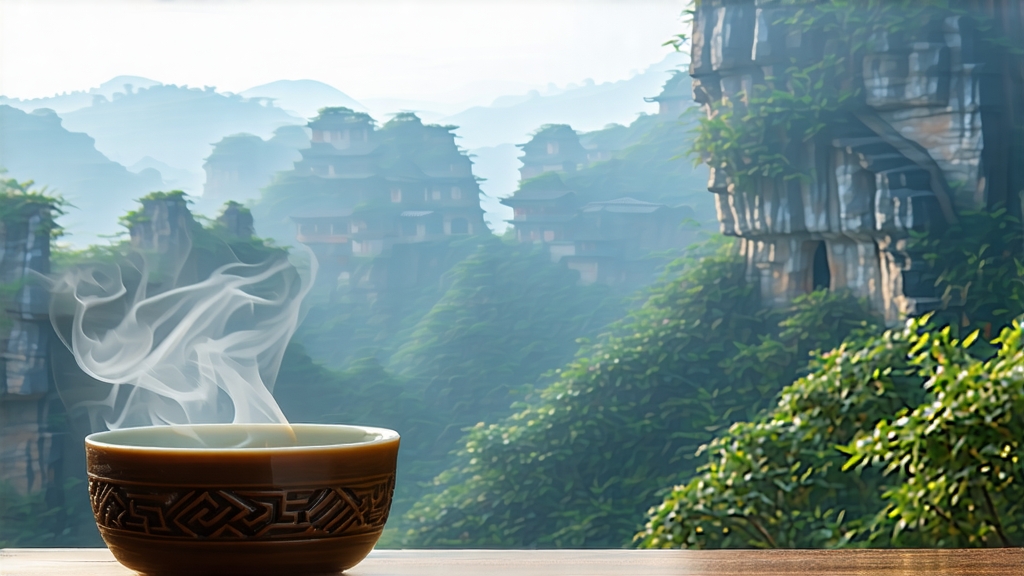
If green tea is China’s springtime whisper and pu-erh its autumnal soliloquy, then Da Hong Pao—Big Red Robe—stands as the twilight aria of Chinese oolong. Born among the vertiginous basalt cliffs of northern Fujian’s Wuyi Mountains, this tea carries the scent of mineral-rich mist, the echo of Tang-dynasty monks, and the lingering warmth of Qing-era imperial silk. To drink it is to taste China’s geological memory, shaped by fire, stone, and human devotion.
Legend first. During the Ming dynasty, a scholar trudging toward the capital examinations fell ill on the steep Wuyi paths. Monks from the Tianxin Temple brewed leaves plucked from four stunted bushes clinging to a cleft in Jiulong Ke, the “Nine-Dragon Gorge.” The infusion revived him; he passed the palace exam, returned in crimson robes, and draped the garment over the bushes to honor their gift. The name Da Hong Pao—literally “Big Red Robe”—was fixed in stone and story. Whether myth or marketing, the tale captures the tea’s aura: imperial, medicinal, almost talismanic.
Geology is less romantic but more decisive. The Wuyi range is a UNESCO geopark where 400-million-year-old volcanic tuff has weathered into narrow gorges called “danxia.” Day-night temperature swings of 15 °C force the tea bushes—often 30-year-old clones of the original “mother trees”—to grow slowly, thickening cell walls and concentrating aromatic compounds. Rainwater percolates through mineral strata, picking up calcium, magnesium, and potassium before reaching the roots. The result is yan yun, “rock rhyme,” a textured finish that Chinese tasters describe as the echo of stone in the throat: cool, metallic, lingering like struck bell bronze.
Da Hong Pao is not a single cultivar but a stylistic family. At the top sit the “mother-tree” cuttings, today protected by the state and no longer harvested; a 20-gram auction lot fetched RMB 208,000 in 2005. Commercial grades descend through “purebred” Beidou or Qidan clones (genetic matches to the originals), high-altitude “queshe” (sparrow-tongue) leaf shapes, and finally the accessible “commodity” blends that marry Wuyi leaf with neighboring regions to meet global demand. What unites them is processing, an eight-step choreography that turns raw leaf into dark, ribbon-twisted oolong.
Plucking begins at dawn on mist-cooled April mornings. Two leaves and a bud are snapped, never cut, to keep cells intact. The first bow to tradition is yaoqing, “wavering green”: baskets of leaf are cradled over dying charcoal embers so that infrared heat, not flame, drives off surface moisture while jump-starting enzymatic oxidation. Workers rhythmically shake the baskets every ten minutes; the gentle bruise breaks leaf edges, allowing oxygen to kiss catechins and convert them into theaflavins and thearubigins that give Da Hong Pao its cocoa-crimson liquor.
After two hours the leaf is spread on bamboo trays for banqueting, a 4-hour rest where oxidation climbs toward 40 %—halfway to black tea. The critical kill-green (shaqing) follows: leaves are tumbled in a 220 °C drum for ninety seconds, halting oxidation while locking in floral lactones. What distinguishes Wuyi craft is the double charcoal roast. Bundles of leaf are wrapped in white cotton cloth, placed on three-tier bamboo racks, and baked over a low ember fire of local hardwood for 6–8 hours, rested for a month, then roasted again. Master roasters judge heat by hand, hovering palms above baskets the way pizzaiolos test oven floors. Over-roast and the tea tastes of burnt toast; under-roast and grassy astringency remains. The goal is mei huo, “beautiful fire,” a caramelized depth that reads as roasted almond, pipe tobacco, and the scent of warm granite after rain.
Western drinkers often meet Da Hong Pao in tearooms where Gongfu aesthetics—tiny clay pots, ivory-colored tasting cups, red sandalwood trays—frame the ritual. Yet the essence is control of variables: 1 gram of leaf per 15 ml of water, 98 °C water just off a rolling boil, and a cascade of flash infusions beginning at 5 seconds. The first rinse is discarded, a